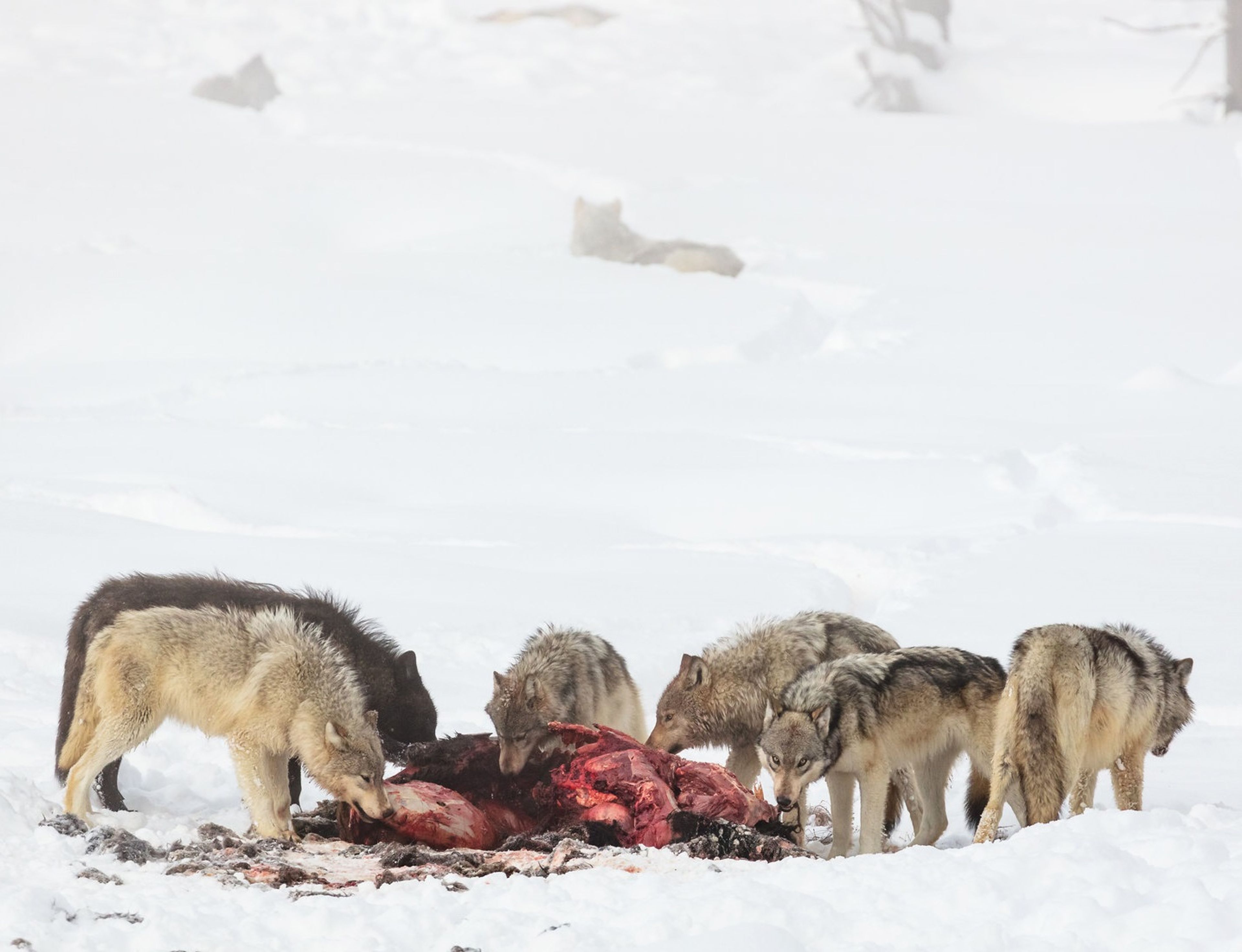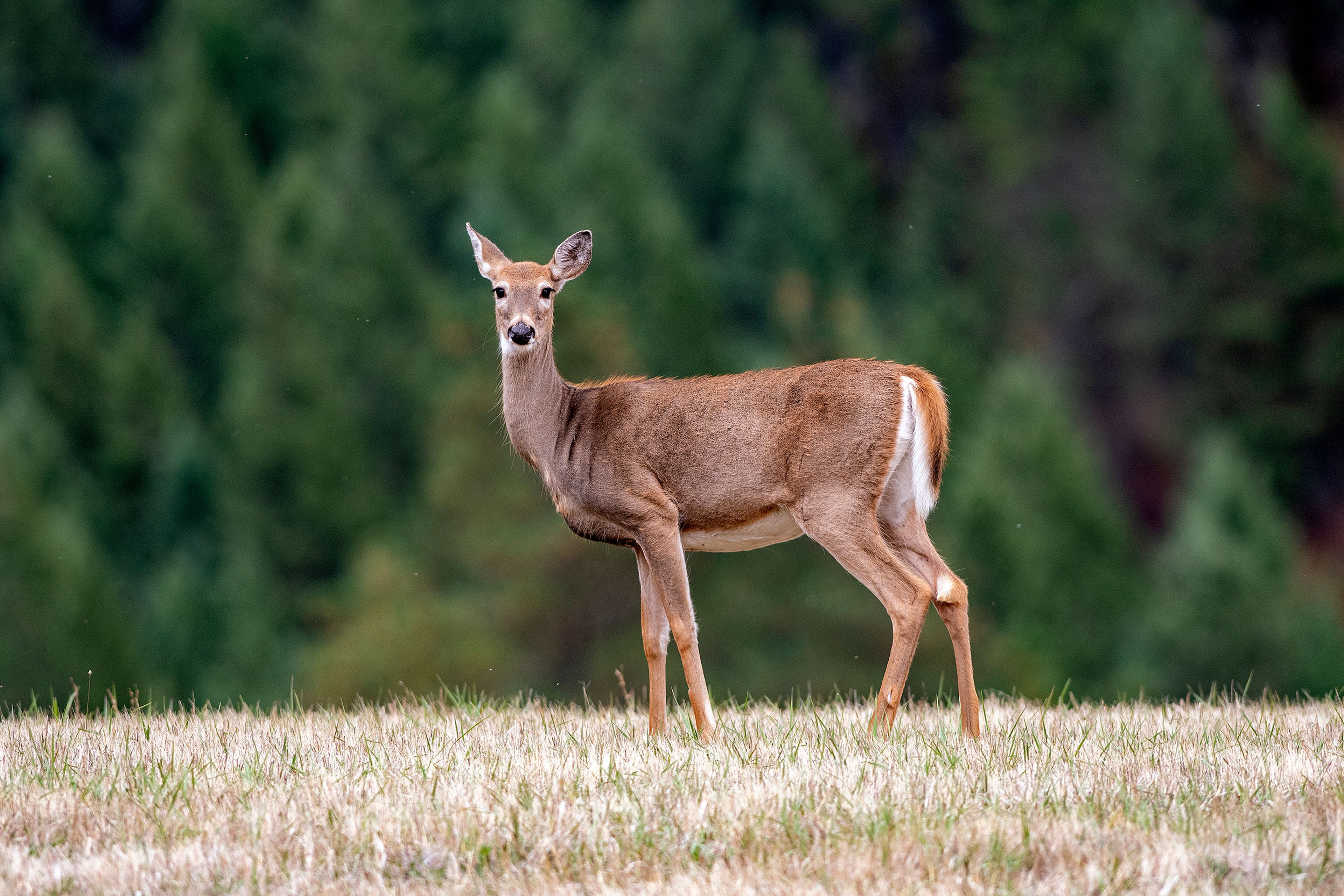Wolves, elk and aspen
Scientists explore effects of predators’ reintroduction on tree growth in Yellowstone
For more than a decade, a passionate debate has reverberated within Yellowstone National Park’s scientific community regarding wolf reintroduction.
Did wolves improve aspen growth by helping to reduce elk populations, called a density-mediated indirect effect (DMIE)?
Or did the mere presence of wolves make elk so nervous they didn’t eat as many aspen, or avoided areas where they may have encountered wolves, called a trait-mediated indirect effect (TMIE)?
“Scientists don’t just want to show what’s happening; we want to figure out why it’s happening,” explained Kristin Barker, research coordinator for the Beyond Yellowstone Program based in Jackson, Wyo. “Because if we don’t know why something happens, we don’t know whether it’ll happen in other places or times — meaning we have no universal understanding of how the world actually works.”
Trophic cascade
These two effects — DMIE and TMIE — are causes of trophic cascades.
A trophic cascade occurs when top predators — such as wolves — “limit the density and/or behavior of their prey,” according to the journal Nature. In Yellowstone, the wolves’ main prey is elk. With fewer elk on the landscape, following wolf reintroduction, the “survival of the next lower trophic level” — in this case young aspen — rebounds because there aren’t as many elk eating the tasty trees.
With more trees, there’s the potential for a cascading effect of more songbirds and possibly beavers on the landscape.
Given all of this, why does it matter if wolves limit the density or behavior of their prey? Barker explained it this way:
“One way to think about this is like a rancher — there’s a difference in whether you take a financial hit because wolves are eating your cows, or because wolves are stressing out your cows so much that they don’t put on much weight or can’t carry pregnancies to term,” she wrote in an email. “Eating cows is a numerical problem. Stressing cows is a behavioral problem. If you know the problem, then you know what you might be able to do about it, and you could even be able to give your buddy in Colorado advice about the problems they might expect to have if wolves get reintroduced nearby. (I’m not saying that all ranchers have trouble with wolves, or that cows are always stressed out by wolves. Just an example to illustrate the point.)”
Latest research
Yellowstone’s wolves have generated reams of studies since their reintroduction began in 1995. From this vast body of information, a group of scientists report in a newly published paper they have a nearly definitive answer to the burning question of density vs. trait, or DMIE vs. TMIE.
“Despite a wealth of studies arguing for the primacy of TMIEs, both in Yellowstone and elsewhere, we found little evidence of a TMIE of wolves on aspen,” the authors concluded.
“The primary driver of decreased elk browsing pressure and increased aspen tree regeneration was a reduction in elk population density, a ‘density-mediated trophic cascade,’ caused by predation from multiple predators — wolves, bears, cougars and hunters,” said Dan MacNulty, a co-author of the study and Utah State University wildlife ecologist.
The study, titled “The primacy of density‐mediated indirect effects in a community of wolves, elk, and aspen” was published in the journal Ecological Monographs in October. The study’s other authors include Elaine Brice, Eric Larsen and Dan Stahler.
“This finding provides a more accurate portrayal of this now text-book trophic cascades case study,” said Stahler, Yellowstone senior wildlife biologist for the wolf, cougar and elk projects. “It refines a widely told story about how wolves have changed Yellowstone, which has erroneously claimed elk’s fear of wolves and avoidance of risky places where aspen sometimes grow has driven some of the documented aspen regeneration.”
Not so fast
Oregon State University researchers Robert Beschta and William Ripple have long argued for a trait-mediated indirect effect (TMIE) of wolves on aspen.
Beschta said he and Ripple never claimed the landscape of fear hypothesis was the “whole story,” but it “has likely been a component of the changes in Yellowstone.”
“When you take a hyper-abundant elk population of about 14,000 down to about 2,000 (their Figure 3) it is pretty obvious that density will be an important factor in affecting the recovery of previously degraded plant communities,” Beschta wrote in an email. “But, imbedded in that transition are behavioral effects that may be changing over time and space, and are difficult to evaluate with regard to any resulting effects on plant communities.”
Instead, Beschta argued “Yellowstone’s trophic cascade reflects both density and behavior dynamics — each contributing in ways we are only beginning to understand.”
He also said, “An abundance of studies clearly indicate that the return of wolves has redefined the ecological balance of Yellowstone.”
Tree data
Interestingly, one of the latest study’s co-authors, Eric Larsen of the University of Wisconsin-Stevens Point, also provided aspen information for the Ripple and Beschta studies when he was still a PhD student. Larsen “established the aspen measurement plots that provided the long-term data forming the basis of our study,” MacNulty noted.
With Larsen’s analysis now possessing 19 years of data, combined with “similarly long-term data on wolf predation risk and elk population size from the Yellowstone Wolf Project and the Northern Yellowstone Cooperative Wildlife Working Group, our study provides the most rigorous test to date of the effects of wolf predation risk on elk browsing and aspen regeneration,” MacNulty said.
“We found little evidence of a behaviorally mediated trophic cascade, finding instead that the primary driver of decreased elk browsing pressure and increased aspen tree regeneration was a reduction in elk population density, a ‘density-mediated trophic cascade’, caused by predation from multiple predators — wolves, bears, cougars and hunters,” MacNulty added.
Although Beschta argued the new study has “problems with its plant data,” MacNulty countered Beschta “previously used these same plots to argue that wolf predation risk was an important influence on elk browsing and aspen regeneration.”
Predators
Yellowstone is dense with carnivores. A 2023 study showed the park’s Northern Range contained the highest densities of black bears in the northern Rocky Mountains, 20 bears every 62 square miles.
“This increase in bears was mirrored by an increase in elk calf mortality, with the proportion of radio-collared calves killed by grizzly and black bears increasing from 23% in 1987-1990 to as much as 60% by 2003-2005,” the recent study noted.
There are also now more mountain lions in Yellowstone. The big cats’ favorite food is elk, constituting almost three-quarters of their diet from 1998 to 2004, dropping to about half of their diet in recent years. Cougars also ate more elk calves than adult elk.
Then there are human hunters who have long targeted elk when they leave Yellowstone on winter migrations into Montana’s Gardiner Basin. When elk numbers were high, Montana Fish, Wildlife & Parks allowed heavy cow elk harvests to reduce the population.
“During each of the eight years following the 1995 wolf reintroduction (1995-2002), late-season hunters, together with general season (October-November) hunters, killed a larger portion of the northern Yellowstone elk population (5.7%-18.7%) than wolves did (1.7%-6.2%),” according to research MacNulty conducted in 2020.
“As such, it is evident that wolves alone did not drive the increase in aspen recruitment that we observed,” the most recent study concluded.
MacNulty said his team’s recently published study also lays to rest one other long-held claim.
“Our results support the conclusion of early park biologists and subsequent university researchers that high elk population density was a primary cause of aspen forest loss in northern Yellowstone National Park during the 20th century,” he wrote in an email. “This conclusion was contested after the park implemented its ‘natural regulation’ policy in 1969, which led to very high densities of elk wintering in northern Yellowstone. Proponents of the policy argued that high elk density was not a key cause of aspen loss. Our study suggests otherwise.
Final thoughts
Barker, the Wyoming researcher, tried to understand the DMIE vs. TMIE question with research she conducted on elk winter feedgrounds between 2019 and 2021 near Jackson.
Her study found elk didn’t always change their behavior when they encountered a wolf, but often did when in risky places — but it varied from elk to elk.
“So it makes sense that someone studying an elk population that’s just experiencing wolves right after reintroduction would find different behaviors than someone studying a population that’s had wolves around for generations,” Barker said last October.
As former Yellowstone wolf biologist Doug Smith would often note before he retired in 2022, Yellowstone’s elk were some of the toughest around because of the predator-rich environment. If they fled every time they saw a bear, wolf or mountain lion, they might not stand still for very long.
In Smith’s interpretation of the latest study, he said it doesn’t reject the trophic cascade theory.
“What it says, though, is it’s probably a lot slower than it was originally thought to be,” he said. ”The Ripple-Beschta stuff is still occurring, but it’s not occurring as fast as others had claimed.
“I think the other key finding is it’s got more to do with the density of elk than the behavior of elk, which has been a really big debate,” Smith added.
Smith said the arguments back and forth about trait vs. density mediated effects are “a lot to chew on for the lay reader.” But in Yellowstone, for the past 30 years, the debate on the topic has been “red hot.”
“So I think it is an important paper,” Smith said.
Yellowstone Wolf Project leader Dan Stahler was diplomatic in recognizing the great breadth of research that predates the paper he coauthored.
“There is great importance to the contributions of the Ripple and Beschta and all the other researchers studying trophic cascades in Yellowstone over the last several decades,” he wrote in an email. “Only through this process of science and debate are we better able to unravel the complexity of this ecological tale.
“And we must recognize there are limitations to observational studies like ours that cannot fully disentangle density and behavioral changes to explain the relationship between wolves, elk and aspen — that would require some measure of experimental control.”
More than anything, the takeaway from dueling studies and theories may be that there are no simple answers to very complicated questions in part because, as Stahler noted, “Yellowstone’s ecology is complex.”








